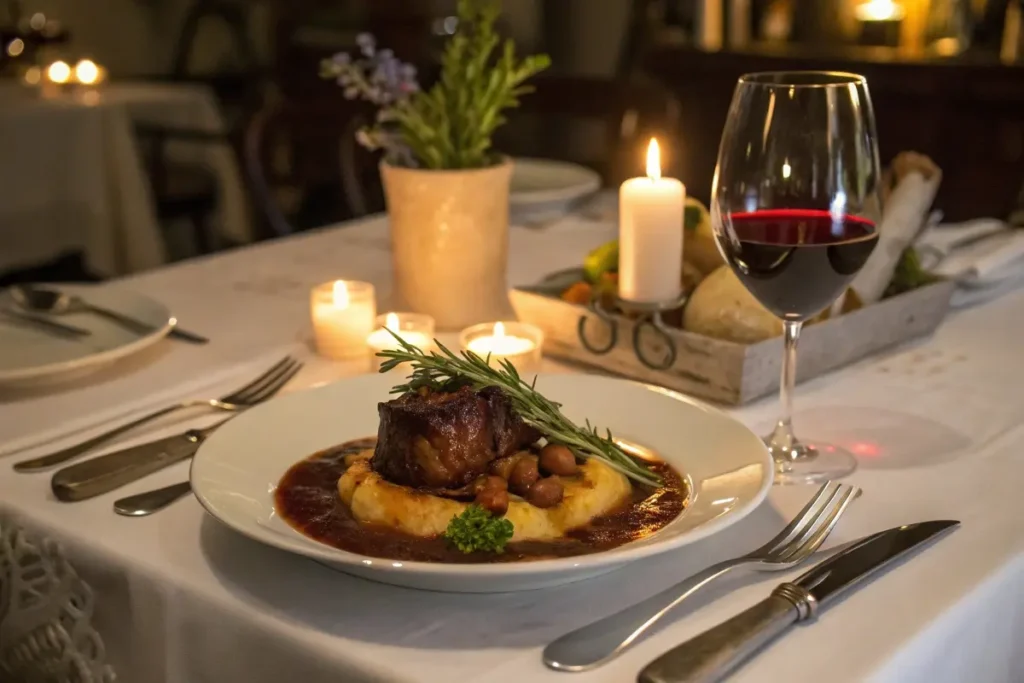Beef cuts can be a maze to navigate for both home cooks and culinary enthusiasts. Among the less famous yet intriguingly named options is the beef banana shank. Within the first few minutes of encountering this term, many ask: What is a beef banana shank? Despite its curious label, the beef banana shank—sometimes called the banana heel or simply part of the shank—is an incredibly flavorful piece of meat best suited for low and slow cooking methods. Like other shank variations, it’s known for its tough muscle fibers and robust taste. Properly prepared, the beef banana shank can transform into a tender, melt-in-your-mouth delight that shines in braises, soups, and more.
Throughout this article, we’ll explore the beef banana shank from every angle. What is beef shank good for? It’s ideal for hearty stews and slow-cooked dishes. Is shank a good cut of beef? Absolutely—especially if you aim for comfort food that exudes deep, rich flavors. What is the preferred cooking method for shank? Generally, a patient braise or simmer. Ready to delve deeper? We’ll examine everything from the cut’s unique composition to cooking tips and historical context. And if you want to complement these dishes with a Japanese flair, consider checking out our Japanese Stew and Soup Ideas for more inspiration. Let’s begin our deep dive into one of the most underrated cuts in the beef world.
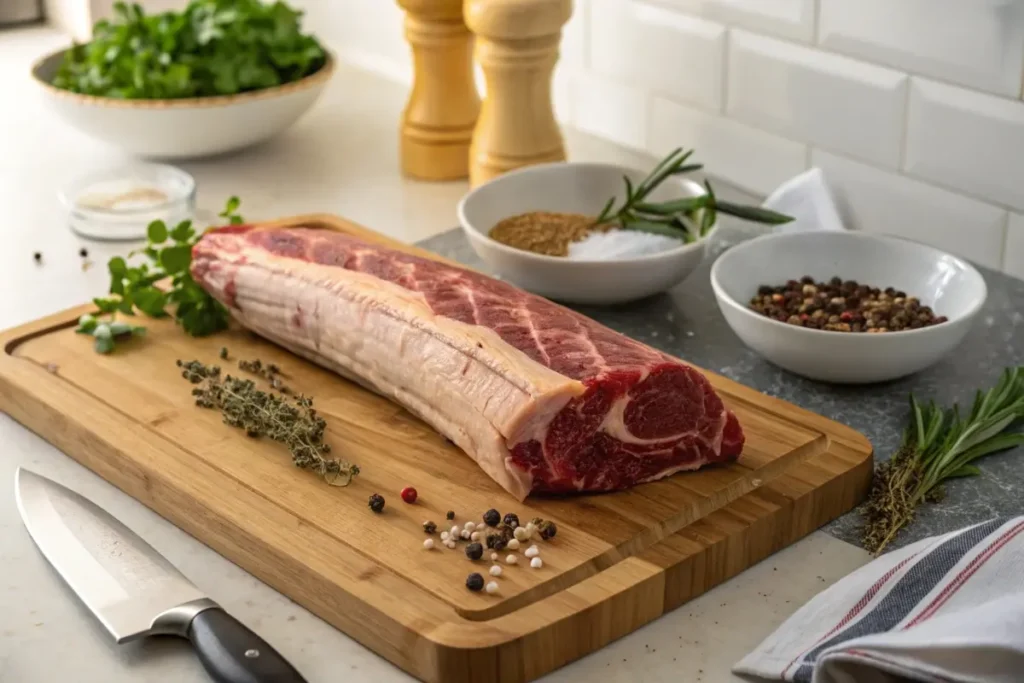
1. Getting to Know the Beef Banana Shank
1.1 Basic Anatomy and Terminology
Located in the lower leg portion of the cow, the beef banana shank typically includes tough, sinewy muscles that carry a heavy workload during the animal’s life. But why the “banana” moniker? The name often arises from the shape—slightly curved or elongated, reminiscent of a banana’s contour. This cut sometimes goes by “banana heel” or is grouped under “shank” subcategories, which can cause confusion for consumers and butchers alike.
Within the shank category, you may see:
- Front Shank (Foreshank): Common for soup bones or braising.
- Hind Shank (Hindquarter): Possibly subdivided into slices, often sold as osso buco style if from the rear leg.
- Banana Shank: A portion recognized by some butchers for specific culinary applications.
1.2 Flavor Profile and Texture
Rich, Collagen-Rich Flavor
- Shanks are famously high in collagen. When cooked slowly, collagen gelatinizes, creating mouthwatering, velvety sauces and tender meat.
- Expect deep beefiness that stands up to bold seasonings like garlic, soy sauce, or chili.
Tough Yet Transformable
- Raw shank is firm, reflecting the muscle’s constant use. Proper cooking—like braising or stewing—breaks down connective tissues. The reward? Succulent bites that literally fall apart.
1.3 Why Bother with a Tough Cut?
Economical Advantage
- Cheaper than premium steaks or roasts, the beef banana shank offers an excellent cost-to-flavor ratio.
- Despite needing extra time, its final result can rival more expensive cuts in taste and texture.
Versatility
- Shank-based dishes adapt across cuisines: from Mexican birria stew to Italian osso buco analogues.
- Perfect for adventurous home cooks who appreciate layering flavors in soups, curries, or braises.
1.4 Cooking Methods Overview
- Braising: A classic approach—simmer the shank in liquid, like wine or stock, for hours.
- Stewing: Cut the banana shank into cubes or chunks, ensuring even cooking in a hearty stew pot.
- Slow-Roasting: Less common but feasible with ample liquid and sealed foil or a Dutch oven.
- Smoking: Some pitmasters experiment with smoked shanks, though the process can be lengthy.
For recipe references, see our Minced Beef Japanese Recipe to spark an idea of how versatile beef can blend into stew-like dishes. While minced beef differs from shank, the underlying principle—slow-cooked, savory flavor—remains relevant.
A Word on Slicing and Handling
When purchasing the beef banana shank, ask your butcher if they can slice or cross-cut it if needed. Because of the shape, portioning can help manage cooking times and ensure thorough braising. Some prefer bone-in pieces for that extra marrow infusion—others stick to boneless. Either way, properly executed slow cooking methods harness the potential of this cut’s connective tissues, culminating in a luscious meal.
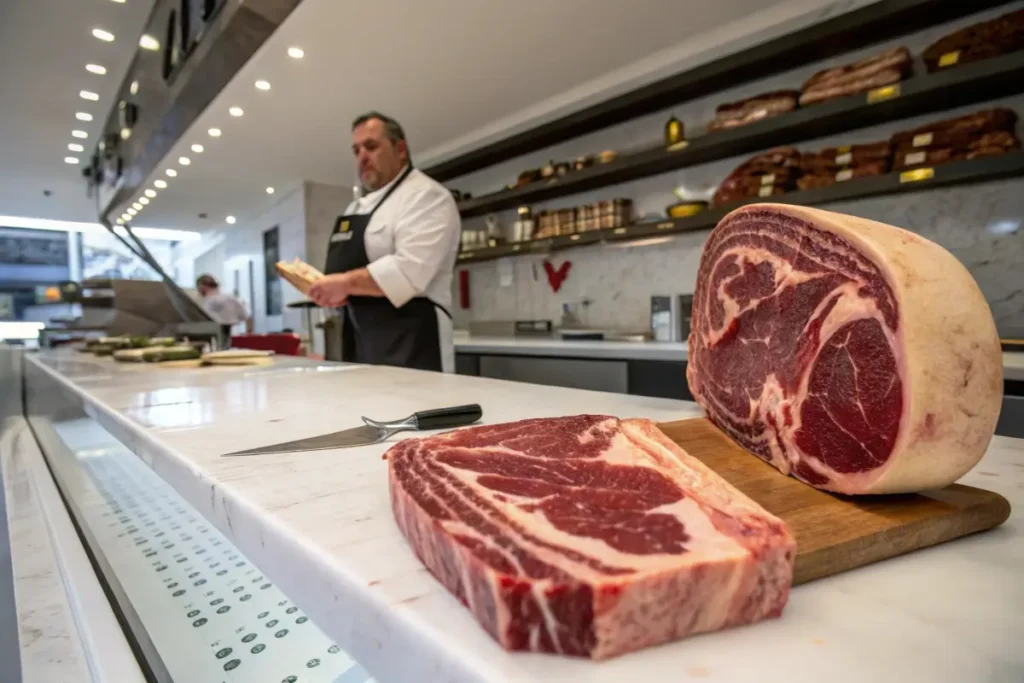
2. Culinary Applications and Recipe Ideas
2.1 Braised Beef Banana Shank Basics
Liquid Choices
- Wine, beef broth, or even coconut milk can serve as a braising medium. Each imparts unique depth.
- Stir in aromatics: onions, celery, carrots, herbs. The base marinade eventually forms a rich sauce.
Techniques
- Sear the banana shank first to develop color and lock in juices.
- Deglaze the pan with your chosen liquid to incorporate all the browned bits.
- Let the shank simmer or slow-cook for 2-4 hours. The exact timing depends on thickness and personal tenderness preference.
2.2 Stewing or Curry Style
Cutting the banana shank into chunks suits stews or curries—like a Japanese curry twist.
- Sauté onions and spices in a pot.
- Add shank cubes and toss them for a quick sear.
- Pour in broth or curry roux.
- Simmer until tender, about 2-3 hours.
Tip: Pair with vegetables like potatoes, carrots, or daikon for a hearty, fiber-rich meal. If you crave a classic Japanese flavor approach, explore our Japanese Chicken Fried Rice Recipe for complementary side dishes. Swap or add the braised shank to create your own meaty spin.
2.3 Smoking or Grilling the Shank
While not mainstream, smoking a banana shank offers an unconventional route.
- Low and Slow: Use a smoker at 225-250°F. Let the shank absorb smoky flavors for several hours, then wrap it in foil with some liquid to finish the cook.
- Texture: Achieving fall-off-the-bone tenderness demands methodical timing—often 5+ hours.
2.4 International Inspirations
Chinese Braised Beef Shank
- Typically uses soy sauce, star anise, chili. The thick sauce coats each piece.
- Chilled, sliced thinly for a cold appetizer—popular in certain regions as a savory snack.
Birria Shank
- Incorporate the banana shank into spicy stews from Mexico.
- Chili peppers, cumin, oregano, and slow-cooking unify into succulent taco fillings or stew-based dishes.
Italian Osso Buco–Inspired
- Substitute beef banana shank for veal shanks, braising in tomatoes, wine, and mirepoix.
- Serve with gremolata for a fresh, citrusy contrast.
2.5 Sides and Pairings
Because the shank’s flavors are so robust, choose sides that lighten or complement:
- Creamy Polenta: Absorbs braising juices.
- Steamed Rice: Basic, but perfect for soaking up savory sauces.
- Sautéed Greens: Spinach or kale cut through the richness.
- Roasted Root Vegetables: Carrots, parsnips, or sweet potatoes for a sweet-savory synergy.
If you’re in the mood for a complete Japanese twist, check out our Japanese Scallop Recipe for surf-and-turf combos: succulent shank and tender scallops can anchor a fusion dinner party. The interplay between land and sea flavors can yield a remarkable feast.
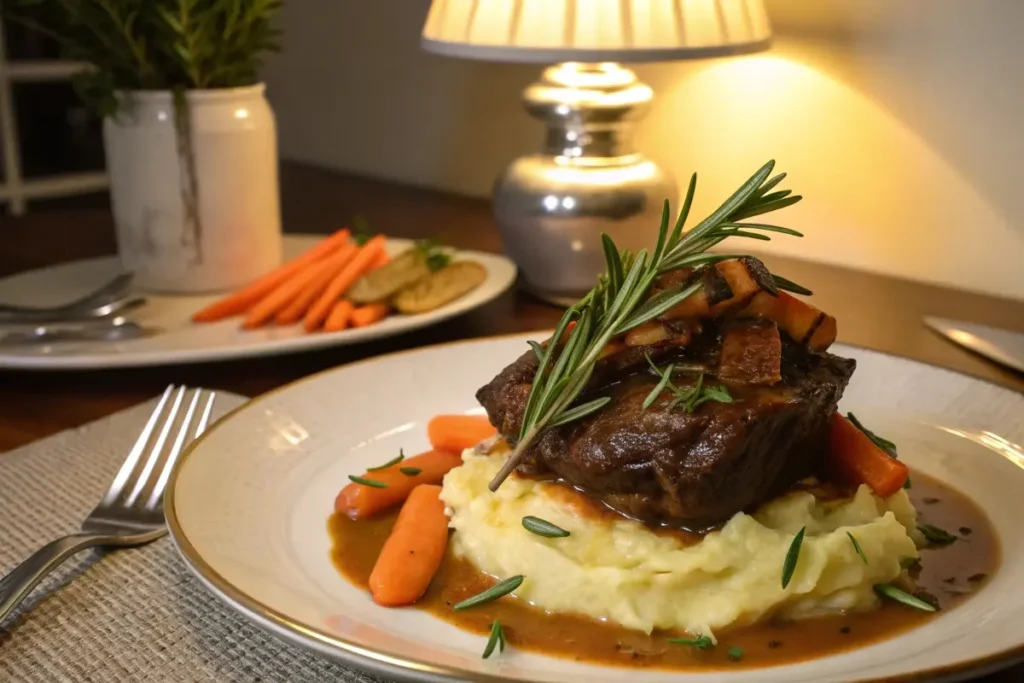
3. History/Context
3.1 From Workhorse Cut to Undervalued Treasure
For centuries, anatomically tough portions like shank were relegated to peasant or rustic dishes. While higher-end cuts were coveted, the shank was prized by thrifty cooks for its robust flavor and collagen content. Historically, it was integral to soups and stews that nourished laborers or families on tight budgets. Over time, though overshadowed by popular steaks or roasts, the shank’s deep taste never fell out of favor among those appreciating slow, homestyle cooking.
3.2 Butchery and Regional Names
The “beef banana shank” label likely arose from local or regional naming conventions. The shape or trimming style can differ from standard cross-cut shank or “osso buco” slices. Chinese markets sometimes highlight “banana heel beef,” referencing a portion of the leg. Meanwhile, Western butchers might or might not use the “banana” descriptor, leading to confusion about identification. It remains a testament to how each region’s butchery traditions and culinary heritage shape naming norms.
3.3 Culinary Crossroads
- Asia: In China, braised beef shank is beloved for chilled appetizers or fiery stews. In Japan, beef shank can find a place in slow-cooked sukiyaki or curry variations, though it’s not the top cut.
- Europe: Known for pot-au-feu in France, osso buco in Italy, or hearty soups across Eastern Europe. Shank’s universal role is being a flavorful base for comfort dishes.
- Americas: Shank appears in homey stews, chili con carne, or smoked barbecue traditions. Latin American cuisines also appreciate its potential for rich, spiced dishes.
3.4 Modern Popularity Surge
As farm-to-table philosophies spread, diners show renewed curiosity for secondary cuts. Chefs champion “nose-to-tail” cooking, turning lesser-known portions like shank into gastronomic highlights. The “banana shank” has thus garnered attention among those seeking economical, eco-friendly, and palate-pleasing solutions. Culinary schools and cooking shows highlight how technique trumps cost—demonstrating that with time and skill, any cut can become gourmet.
External Influences: E-commerce platforms and online butchers now offer specialty cuts, including banana shank. Enthusiasts can easily procure them, experiment with recipes, and share experiences on social media. The result is an evolving appreciation for once-overlooked sections of the beef leg. For more inspiration on unexpected cuts, see our Authentic Japanese Short Ribs Recipe for how tough cuts can transform into succulent delights.
Over generations, the banana shank’s legacy underscores a core principle: no piece of the cow is “waste.” Each cut, when respected and properly cooked, yields incredible gastronomic rewards. The next time you crave something hearty yet full of character, remember that the beef banana shank stands ready to deliver melt-in-your-mouth satisfaction.
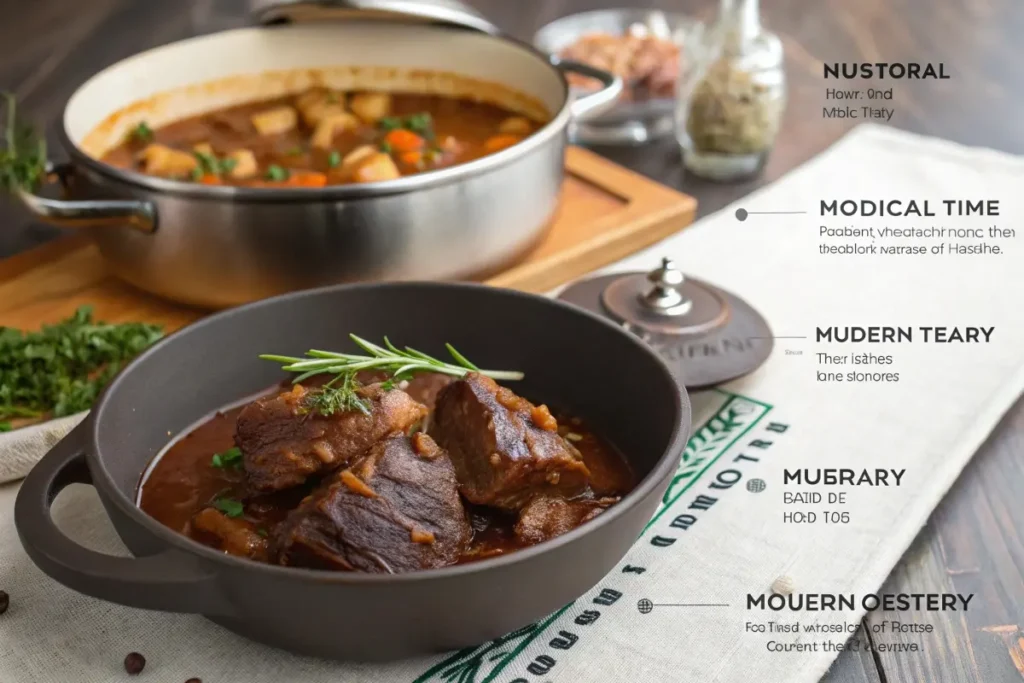
4. Practical Examples/Use Cases
4.1 Family Dinners and Weeknight Meals
Scenario: You have limited time but desire a hearty, nutritious dinner.
- Approach: Prepare the banana shank in a slow cooker before work—season, add stock, onions, and carrots. By evening, you’ll have succulent beef ready to top rice or noodles.
- Benefit: Minimal effort, maximum flavor. Perfect for busy families wanting comfort food without constant kitchen supervision.
4.2 Meal Prep and Leftovers
Scenario: Planning a weekly meal prep for lunches.
- Approach: Braise a large banana shank over the weekend. Shred or cube the meat. Store the sauce separately. Reheat in microwavable containers with grains or vegetables.
- Upshot: A budget-friendly protein supply that remains tender throughout the week. The collagen-rich sauce can be reincarnated as gravy for mashed potatoes or a base for soups.
4.3 Entertaining Guests
Scenario: Hosting a dinner party with globally curious foodies.
- Approach: Create a Chinese braised beef shank or Italian osso buco–style dish, substituting the banana shank for fancier cuts. Garnish with fresh herbs, pair with wine or tea.
- Result: Guests enjoy a complex, slow-cooked highlight. Impress them with your knowledge of shank’s underdog status and how you’ve elevated it into a gastronomic delight.
4.4 Restaurant Innovation
Scenario: A local bistro wanting to expand the menu.
- Approach: Feature “Braised Banana Shank with Miso Glaze” for a Japanese-inspired twist. Or create a “Shank Tacos” item with spicy adobo marinade.
- Benefit: Economical yet flavorful protein that resonates with diners who crave creative, slow-cooked specialties. Stands out from standard steak or chicken dishes.
If you’re seeking even more adventurous pairings, you can glean ideas from our Japanese Barbecue Sauce Recipes to craft a marinade or glaze. Slather your banana shank with tangy-sweet barbecue sauce, then slow-roast or grill for a fusion approach. These examples demonstrate how a once-humble cut can be leveraged across home kitchens, restaurants, and beyond, delivering memorable meals with minimal fuss.

5. FAQs about Beef Banana Shank
5.1 What is a beef banana shank?
It’s a segment of the cow’s lower leg—often from the hindquarter—shaped somewhat like a banana, hence the name. Rich in connective tissue, it suits long, slow cooking to unlock its robust flavor and tenderize the tough muscle fibers.
5.2 What is beef shank good for?
Beef shank is excellent for braising, stewing, or soups due to its high collagen content. When cooked low and slow, the collagen breaks down, yielding tender, succulent meat and a savory sauce. It’s ideal for comfort dishes in many cuisines, from Chinese spiced shank to Italian osso buco–style braises.
5.3 Is shank a good cut of beef?
Absolutely—though it requires patient cooking. If you’re seeking a quick stir-fry, shank won’t suffice. But for hearty meals that highlight deep beef flavors, shank can outperform pricier cuts. Economical, adaptable, and rewarding, it’s cherished by those who appreciate slow-cooked fare.
5.4 What is the preferred cooking method for shank?
Most cooks opt for braising—simmering in liquid at a low temperature for extended periods. This method dissolves tough fibers, forming a rich sauce. Other approaches include slow roasting, stewing, or even smoking. Any technique that prolongs cooking and retains moisture helps maximize tenderness.
5.5 How does banana shank differ from a regular shank?
Primarily in shape and possibly trimming style. The “banana” descriptor points to a slightly curved or elongated portion of the shank. Flavor and texture remain consistent with standard shank characteristics—tough muscle that transforms under low, moist heat.
5.6 Can I find banana shank at typical grocery stores?
It may not be labeled as “banana shank” specifically. Butcher shops and specialty stores sometimes carry it or can cut it upon request. Online meat purveyors might list it as “banana heel” or part of the hind shank. If you’re struggling to locate it, ask the butcher for the hind leg section that’s elongated and often used in braises.
5.7 Any recommended side dishes?
Try pairing braised banana shank with mashed potatoes, polenta, steamed rice, or roasted root veggies. For a Japanese-inspired spin, see our Vegetables Japanese Recipe for miso-glazed or soy-based veggie sides that complement the beef’s savory richness.
Conclusion for Beef Banana Shank
The beef banana shank offers a prime example of how patient cooking and clever seasoning can elevate a humble, underutilized cut into a sumptuous meal. Despite its tough muscle fibers, this elongated portion of the cow’s hind leg transforms into succulent, fork-tender bites under the magic of low and slow techniques like braising, stewing, or roasting. Whether you’re seeking budget-friendly alternatives to pricier cuts or simply relish the intense beef flavors and velvety sauces that shank provides, this piece of meat won’t disappoint.
Ready to give it a try? Start small: a simple braise with onions, carrots, and red wine. Or venture into global cuisine by adapting a Chinese braised shank or a spicy Latin stew. For more inspiration, check out our Authentic Japanese Short Ribs Recipe to see how slow cooking can transform robust cuts. With the beef banana shank, the possibilities are endless—and each tender, flavorful bite rewards your effort and time. Embrace this unsung hero of the beef world, and let your kitchen creativity shine.
